
Aquatic facilities, and water fountains, in particular, are integral to urban development and innovation. They can completely transform the appearance and atmosphere of a space, to enrich the built environment for a much more enjoyable experience.
In many cities across the world, there has sometimes been a rush to quickly develop urban areas, with the main focus on creating as much office and retail space as possible. In this situation, the overall goal has often been to generate maximum financial profit.
However, city planners these days are now much more aware of other issues, such as the need to also consider and promote the wellbeing of city residents and visitors. So, thankfully, the focus is increasingly turning toward the quality of this urban space, rather than just the quantity.
This article explains the top 3 benefits of aquatic facilities such as urban fountains when they are incorporated within urban innovation and development projects.
As a result, this has led to a move away from “concrete jungles” toward a softer and more pleasant urban environment. This can be seen in developments that increasingly demand green spaces such as public parks, living buildings with a sustainable design, pedestrian-only zones without any polluting or dangerous traffic, and a more natural and peaceful environment by incorporating aquatic facilities such as urban fountains.
The main benefits of using fountains in urban development can be grouped into three categories: beautification of the space, cooling effects, and promoting tourism. Each of these categories is discussed in more detail below.
1. Beautification of the space
The use of one or more fountains can help to create a natural atmosphere in parks and public gardens. This comes from the sound and visual aesthetic of using one of nature’s most precious resources: water.
Fountains come in all shapes and sizes, from a small ornamental fountain and the magnificent Trevi fountain in Rome to a dry deck fountain (funsquare) with numerous high-speed, interactive vertical water jets for play or display. These fountains might also include visually exciting lights, which can be choreographed for a show or used regularly as night lighting.
In this way, the beautification of space can massively rehabilitate public squares, roundabouts, or municipal zones, for example, so that they meet the needs of modern society.
2. Cooling effects
The urbanization of a city can lead to an increase in local temperatures, due to the buildings, pavements, and so on absorbing and retaining heat, that is known as the urban heat island effect. The results of this are heat-related illness and mortality, increased energy (cooling) costs, and more air pollution. This effect is also being increased by global climate change, leading to ever-higher temperatures in some regions.
However, the good news is that water fountains can play a role in reducing the urban heat island effect. This is because water reduces the local temperature through the process of evaporation, which transports heat out of the city. Also, moving or flowing water, such as in fountains, is much more effective at conducting this heat transfer from the ground to the air than stagnant water.
In addition, as can be seen on many hot days across the world, water fountains and other aquatic facilities provide an opportunity for people of all ages to cool down, perhaps by dipping their feet in the water, passing through the jets of a deck fountain, or just by splashing their faces to freshen up.
3. Promoting tourism
Interesting, grand, and sometimes even unusual urban fountains can give a healthy boost to the local economy by promoting tourism and local interest. The Trevi fountain in Rome, mentioned above, is a great example of this, as are the Fountains of Bellagio in Las Vegas and the Magic Fountain of Montjuic in Barcelona.
Developing a previously unspectacular, generic, and less traveled urban space into a more pleasant and stimulating environment containing a water fountain means that more people will visit the area. A well-designed fountain adds freshness to any public space, boosting it both socially and economically by attracting more tourists and also local residents. In this way, people from near and far will have a place for leisure, fun, or just simple relaxation.
Across the world, it is clear that more emphasis is now being placed on the quality of the built environment in cities, particularly in terms of wellbeing and sustainability. It’s great news for all of us that it is no longer good enough to just “build, build, build” without any consideration of the liveability of an area, or ensuring that it is fit for the future.
Water fountains and other aquatic facilities have much to offer by enhancing the environment in any urban innovation and development project. They can beautify a previously unremarkable space, enhance the cooling of the surrounding area, and boost the local economy by promoting tourism.

